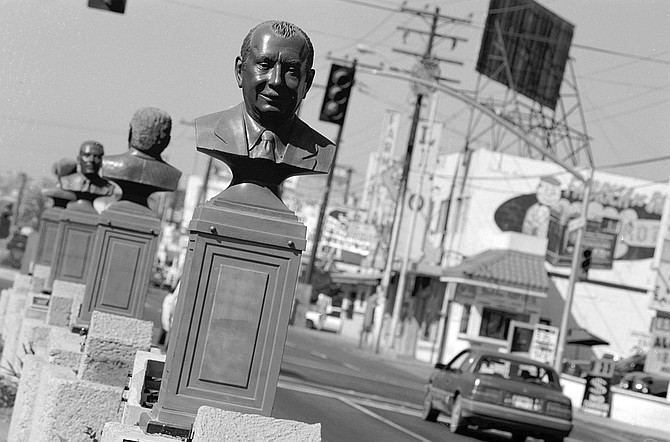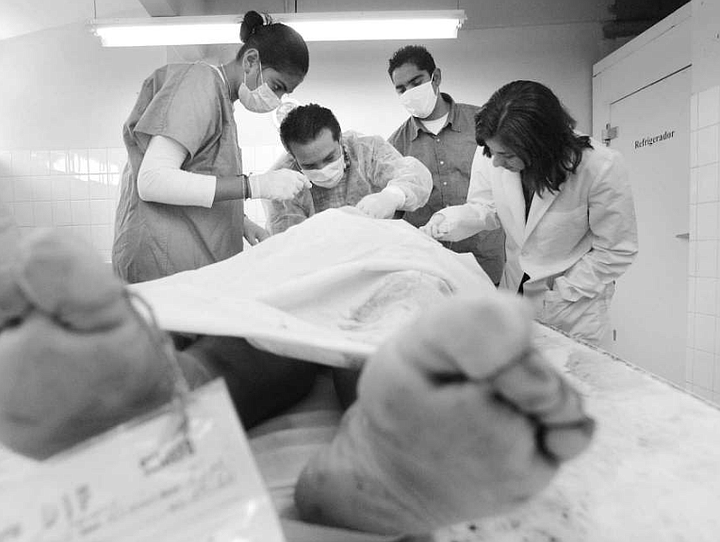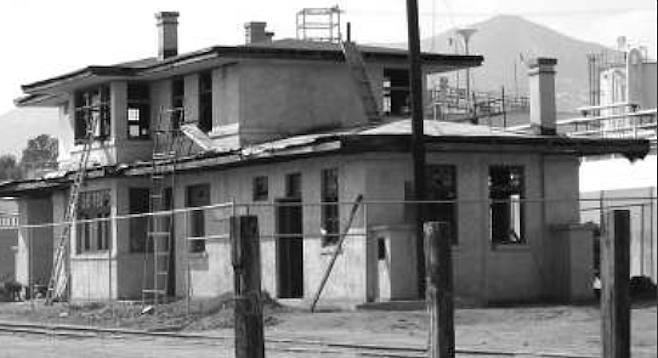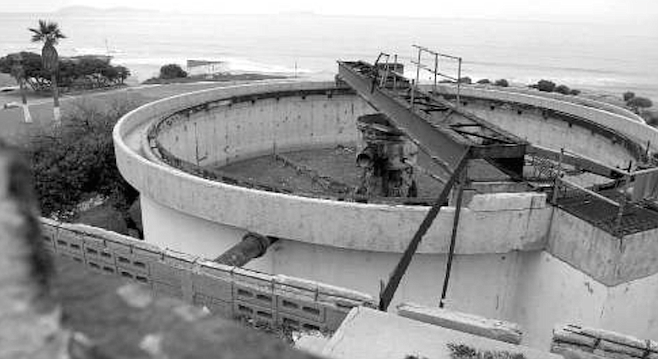
Sixteen bronze busts of "Tijuana's founders" — businessmen, lawyers, politicians — stare westward down Boulevard Agua Caliente.
- Earlier in the day I attended a one-hour lecture given by Dr. Luis Antonio Martínez, a dental surgeon who teaches anatomy to students at the university’s dentistry school. His lecture was attended by 20 first-year students, of whom only 2 were male. Dr. Martínez was preparing his students for their first cadaver dissection. On the blackboard he drew a simple human face — ears, eyes, nose, mouth, chin.
- By Abe Opincar, Oct. 31, 2002

Dr. Luis Antonio Martínez and student. “Every week, while I’m driving to the university to do a dissection, I apologize to the people whose bodies we use."
Photo by Sandy Huffaker, Jr.
- San Diego — Just north of Third Street, on the east side of Avenida Revolución, florista Esperanza Cervantes and her husband José Arias sit in metal folding chairs. Their backs are to the street. Across the street, American rap music thumps from the second-story Club Animale. The two take no notice of it. Nor do they respond to the exploding M-80s somewhere nearby that make others around them jump. After 30 years of selling paper flowers in this spot, they're used to the sights and sounds of this tourist strip.
- By Ernie Grimm, Dec. 12, 2002

Near Third Street and Avenida Revolución. On an average weekend, Cervantes and Arias say they sell about 80 flowers.
- Restoring the Tecate train station is Maria Castillo Curry's obsession. "My Ph.D. dissertation is on railroad stations. When I started work, the railroads were undergoing privatization, and the Mexican government didn't know how many railroad stations were in the country. So I traveled around the country and have 1500 photos of railroad stations in Mexico."
- By Robert Kumpel, Dec. 19, 2002

Tecate train station. "Train stations were mostly kit buildings. You'd buy the blueprint, and they'd all be practically the same building from small town to small town."
- "Just like Florence, just like Rome, Tijuana, too, has its monuments."
- Professor Julio Rodríguez steers his blue Ford through Zona Rio, gesturing at one statue after another.
- "And what are monuments? What do they represent? They represent the dreams, the history, the values of a people, of a culture."
- By Abe Opincar, Oct. 18, 2001

Monument to the free textbook. Seven concrete children scramble up the cover of an enormous concrete book.
- “On the morning of January 20, 1974, the police came. The neighborhood’s name was Tierra y Libertad, ‘Land and Liberty.’ The police marched right into the neighborhood. Perhaps they were state police. I’m not sure. They came in and arrested several people, the leaders of Tierra y Libertad, the people who’d really organized the neighborhood. Others were arrested at work or wherever the police could find them. Worse was to come.
- By Abe Opincar Oct. 10, 2002

Manuel Rosen: “In Mexico I was involved in many projects. I designed the Japanese Embassy in Mexico City, the Olympic swimming pool, a general hospital, the Mexico City convention center."
Photo by Sandy Huffaker, Jr.
- In San Diego County, treated sewage is discharged four miles out to sea from six treatment plants dotting the coast from the border to San Onofre. In Mexico, one treatment plant at San Antonio de Los Buenos, 12 kilometers south of the fence, releases a mixture of treated and untreated sewage down a creek that flows into the surf zone.
- By Ernie Grimm, Oct. 24, 2002

Playas de Tijuana sewer pump station. "The Tijuana River is a natural drainage, and its mouth is where most of the beach closures will take place."
 Facebook
Facebook
 X
X
 Instagram
Instagram
 TikTok
TikTok
 Youtube
Youtube














